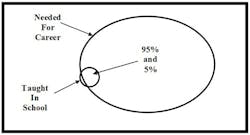Is a college education enough to get young engineers ready for the workforce?
In this column, I will describe the problem. In a later column, I will discuss solutions.
There seems to be general agreement, in both industry and academe, that engineering faculty should have engineering practice experience. If professors are going to teach students how to be engineers, the instructors need to understand engineering. However, there is little practice experience among faculty. As a result, students are guided by the research, science, perfection, individual performance and intellectual values that characterize their teachers; not the contrasting values related to sufficiency, urgency, compliance, partnership, safety, personal effectiveness and fruition that are essential for business success. Furthermore, students are taught engineering science principles, which is good, but in an idealized and out-of-context manner, which is not. While I think we do an excellent job in preparing engineering students with the technical skills needed for them to become engineers, we do it within an academic context. As a result, they do not graduate with the perspectives and expectations to be successful in the disparate context of industrial practice.
I am one of those graduates. It seems it took me two years of work as a process engineer to understand the new environment, to become "industrialized," to be able to be an independent and relevant contributor. Two years is a typical induction period. In all, I worked in industry 13 years. My last role as supervisor of a group of engineers led me to understand the importance of human resource development and the need to accelerate the transition of entry-level engineers from academe to industry.
The two-year transition period is substantially the result of the misdirection of the student persona for engineering function and is often called "the gap." It undermines careers, delays productivity and costs industry. It is not the result of which topics are or are not taught. I see it as a national productivity issue, and industry, academe and government are all involved as stakeholders.
See Also: Automation Companies Prepare Younger Generation to Replace Retiring Employees
We need to bridge the gap. Unfortunately, the "ways," the modus operandi, of those three stakeholders are very different. If we are going to bridge the gap, we need to understand what it is and the environment that creates it. An obvious solution from a business perspective will not work in academe.
I believe that engineering education is substantially fulfilling its multiple missions, that my university is as good a place to work as any, and am particularly very proud of the accomplishment and quality of the students in my program. Having gone back to school for my doctorate after working in industry, I see that what is taught is useful and relevant, even if the instructor is not fully aware of the application context, and I find that instructors without industrial experience can be excellent teachers.
Although happy about my situation and educational outcomes, much needs to be done to improve education. I would like the following criticism to be accepted as an initiative to add value, so that engineering education can achieve what is possible.
Why Is There a Gap?
Some think it is about the topics in the curriculum. We don't teach what a particular entry-level engineer needs to know, such as programming in a particular DCS or PLC. That is not the issue. The curriculum topics are directed by Industrial Advisory Committees, the accreditation agency (ABET), the Fundamentals of Engineering Exam, and collective exchange of best practices and curriculum content sponsored by several professional societies. They are the right topics, but we cannot teach in only four years what one 40-year career needs, let alone the needs of every separate career.
Figure 1 uses a Venn diagram to illustrate the concept of career-relevant knowledge. Ninety-five percent of what we teach in school is useful for any particular career and life, but it comprises only 5% of what the individual needs to be functional, happy and successful.
Figure 1. A Venn diagram of career-useful knowledge.
Education is to provide graduates with adequacy in the fundamental skills of a discipline and certify their fitness to self-learn. Sometimes students and employers think that college education is about teaching the necessary skills. That is partly right, but the subset that can be taught in four years represents the tip of the iceberg. We can only teach the essential minimal set. Employees must learn the other 95%. Sometimes educators think it is about teaching the fundamental skills. That also is partly right, but what is often missing in the faculty understanding of its role is that we need to prepare students to self-learn the other 95%.
The business of academe contributes to the gap. We need funding and stature, and how we get both shapes who we hire as faculty members and how they understand our discipline.
Stature: Academic stature comes from public visibility of intellectual contributions. If creativity led to a great invention, we would quietly patent it, manufacture it, generate income and not need stature. But academe does not invent, manufacture or run businesses. The private sector does that. Academics investigate pre-commercial, years- ahead possibilities and provide the technical and science underpinning of techniques. We publish our findings in the open literature (textbooks and handbooks), providing access to knowledge and tools facilitating those in the practice. Our job description requires each of us to establish a public reputation as an individual expert who advanced the understanding of science and technology. Necessarily for journal acceptance, engineering understanding must be stated in our mathematical language. So we hire creative, self-driven people who can investigate, mathematically analyze, openly publish and establish individual stature. We seek individual performers who are competitive in a public, intellectual, mathematical, one-upmanship game. This is probably not the persona that industry is seeking in a business partner, but it is the persona that is shaping graduates.
Funding: A substantial portion of university funding comes from research grants, which is our primary metric of success and university ranking. Research funding supports the infrastructure, the research activities that lead to stature and the professor's salary.
[pullquote]Most funding comes from the government and is not directed for product or process development. Value creation is the role of the private sector. Academic research funding is aimed at developing the pre-commercial knowledge base (to position graduates to be able to use technology when it becomes practicable in the future), or solving social problems (such as medical, health, or biofuels). Most academic research funding steers the faculty away from solving extant problems for industry. Although disbursed by government agencies, the proposals are judged by the visible national experts, primarily senior academics. So we hire people who can appeal to the established academic values to be successful in getting grants—again probably not the persona that makes a good engineering partner in the private sector.
Experience: It takes about two years immersed in the industrial environment, full-time, subject to industrial performance appraisals, within the energy and competitive aspirations of other new employees and perceiving industry as your exclusive career path to transition from a student to a partner. It takes about five years of experience to be able to identify and articulate the misperceptions of others, to coach for the transition. Although academe does not hire for industrial experience, we recognize that it is a positive attribute, albeit inconsequential to university goals. But both a five-year delay in starting a research career and the industrial values that contaminate purity in proposals are often viewed as a significant negative.
Research: The technical work of professors is related to the exploration of possibilities. It is not even applied research within an entrepreneurial context. It is not development, and certainly not design or operations within a manufacturing context. It is done externally to the context of economics, EHS&LP, or the legal issues associated with contracts, patents and trademarks. When we find success in analyzing one aspect of a problem, we celebrate glorious achievement with a publication. But the success is about one end of the stick; it is related to the tip of the iceberg and is far from a complete comprehensive solution. It is far from describing a sustainable implementation. The academic environment attracts those who are interested in mathematical analysis or concept creation. It does not attract those who are interested in bringing it to fruition. It rewards those who are good at the academic way, directing them further away from engineering utility.
Pedagogy: The business of academe also includes instruction and best practices in teaching contribute to the gap. Pedagogy is the art and science of best practices in getting students to learn. We are aware of this and good at teaching. But consider the context: Students do not yet have industrial practice experience. Accordingly, they cannot relate to the complexity of equipment within the business context. Furthermore, they are learning the fundamental concepts for the first time. So purposely we teach idealized, simplistic concepts that are isolated from confounding distractions. We must create attainable challenges to keep students incentivized. We also have to teach to the masses, but test for individual ability. Accordingly, we assign exercises and tests that can be done by novices, which can be efficiently graded, which have absolutely right or wrong solutions that cannot entangle us in pseudo-legal grading challenges. We have neither the time nor the funding to provide extensive labs or to coach for performance on open-ended projects.
Time: Four years of college cannot prepare a person for a lifetime of skills. When I teach the chemical process control course, I include many practice-relevant aspects, but cannot include all. There is not time in the one control course within the chemical engineering curriculum to fully prepare engineers for process control jobs. Presently, some educators are questioning the need for a process control course within the academically perceived priority of all of the other topics and legislative pressure to reduce the credit hours in the degree requirements.
Survival of the Fittest: Table 1 summarizes the differences in the environment between school and practice, contrasting similar aspects. We prepare students within the environment of the left hand column and promote them for fitness in that environment. We develop their modus operandi for success in school, which misdirects their understanding of what life in the practice is all about. To be able to lead themselves across the gap, they need to understand the "way" that they acquired and the new "way" needed for success in industry.
| STUDENT | ENTERPRISE PARTNER |
| Learning, Internal | Bringing change to fruition, Value creation, External |
| Follow professor's guidance | Leads own studies |
| General studies, Probable importance | Task-specific studies, Necessary |
| Professor evaluates and assigns grade | Self-evaluation of sufficiency |
| Quantify progress by skill inventory | Quantify progress by trail of contributions |
| Simple, idealized, isolated concepts | Complex, interactive, non-ideal reality |
| Individual | Team |
| Old and known, Certainty | New and uncertain |
| No risk, Little accountability to others | Significant risk, Accountability to many others |
| Describe it mathematically | Make it work |
| Abstract (concepts, equations, schematics) | Concrete (equipment, measurements, people) |
| Answer = equation, number, report | Answer = cash flow |
| Write to show technical prowess | Write to get action |
| Understand thoroughly and quantitatively | Understand qualitatively |
| Passive | Active |
| Science and skill focus | Business impact and market focus |
| Perfection | Sufficiency |
| Research | Development |
| Unconstrained, unbounded, freedom | Constrained by laws, regulations, EHS&LP, contracts, economics |
| Self-paced, for personal convenience | Urgency |
| Celebrate youth | Develop adults |
| Solve problems | Realize opportunities |
| Table 1 - Comparing the Student and Engineering Environment | |
One can also contrast the performance measures between academe and industry. We select students for graduation based on their ability to get high grades through knowledge accumulation and success in playing the testing game (speed, elementary, etc.), as defined by the teacher. We recognize them for honors courses, isolated creativity and intellectual achievement, and reward them with letters (after their name). By contrast, industry honors employees for project fruition, for comprehensive sustainable solutions to business relevant opportunities, by facilitation of others, and rewards them with expanded responsibility and independence.
In this column, I have tried to explain the gap. The next one will describe the impact on society and reveal solutions.
About the Author
R. Russell Rhinehart
Columnist
Russ Rhinehart started his career in the process industry. After 13 years and rising to engineering supervision, he transitioned to a 31-year academic career. Now “retired," he returns to coaching professionals through books, articles, short courses, and postings to his website at www.r3eda.com.

Leaders relevant to this article:



